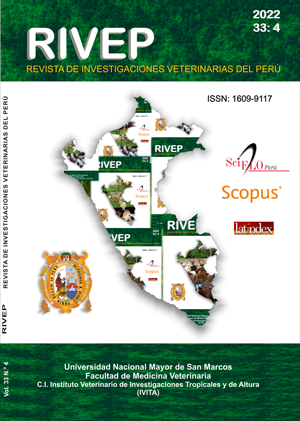Factors related to the textile fibre quality in vicuñas (Vicugna vicugna mensalis) from Apurímac, Peru
DOI:
https://doi.org/10.15381/rivep.v33i4.23348Keywords:
vicuña fleece, medullation, down, spinning finenessAbstract
The aim of this study was to determine the percentage of medullated fibres (PMF), mean fibre diameter (MFD), standard deviation of MFD (SD), coefficient of variation of MFD (CV), percentage of fibres smaller than 30 µm (CF), spinning fineness (SF), curvature index (CI) and fibre length according to the origin of the vicuña, fibre sampling site, age and sex. A total of 228 fibre samples were collected of three body sites of 82 vicuñas (females and males) from four flocks in Apurímac and one in Ayacucho. For the statistical analysis fibre sampling site, origin of the vicuña, age, sex and double interaction were considered as fixed effects. Multiple comparison of means was determined by Tukey's test (α=0.05) and simple regression analysis was used to predict PMF. Depending on the origin of the vicuñas, differences were observed in MFD, SD, CV, CF, SF and fibre length; while for sex and fibre sampling site there were no differences on the textile characteristics and fibre length. The interaction between age and sex showed a lower MFD in adult female vicuñas compared to adult males. The standard deviation of the MFD in vicuñas is an important characteristic to estimate the PMF and the percentage of fibres <30 μm. Likewise, a direct relationship between SD and PMF and between SD and SF is demonstrated.
Downloads
Downloads
Published
Issue
Section
License
Copyright (c) 2022 Rubén Pinares, Virgilio Machaca

This work is licensed under a Creative Commons Attribution 4.0 International License.
AUTHORS RETAIN THEIR RIGHTS:
a. Authors retain their trade mark rights and patent, and also on any process or procedure described in the article.
b. Authors retain their right to share, copy, distribute, perform and publicly communicate their article (eg, to place their article in an institutional repository or publish it in a book), with an acknowledgment of its initial publication in the Revista de Investigaciones Veterinarias del Perú (RIVEP).
c. Authors retain theirs right to make a subsequent publication of their work, to use the article or any part thereof (eg a compilation of his papers, lecture notes, thesis, or a book), always indicating the source of publication (the originator of the work, journal, volume, number and date).



